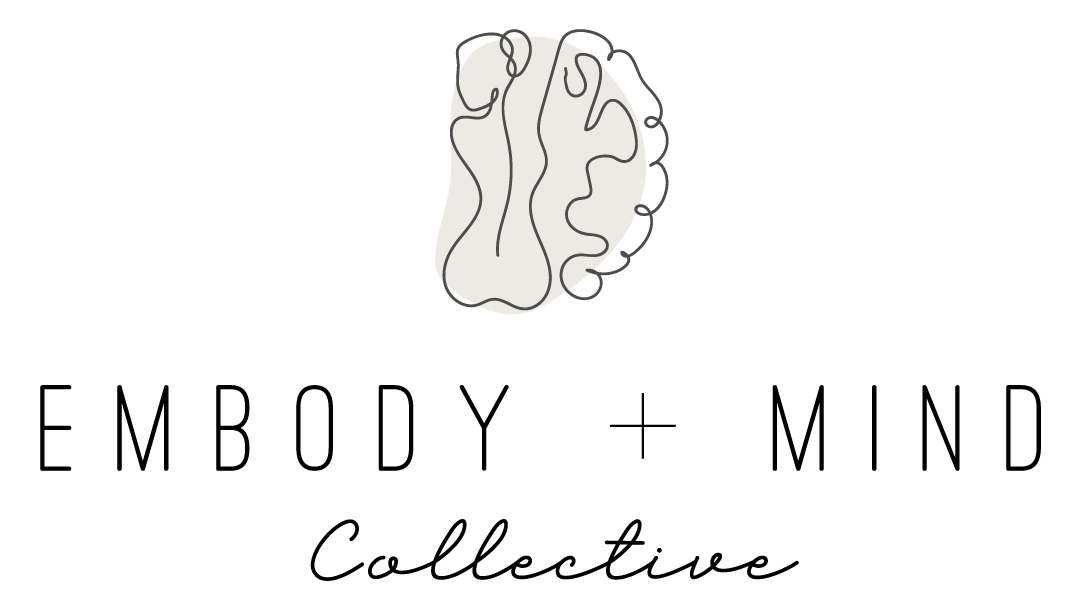Somatic Art Therapy: How We Can Bridge the Gap Between Mind and Body Through Art
By: Shaye Mueller
Here at Embody + Mind Collective, we use body-centered techniques with traditional methods of therapy to help our clients reach healing. And at the heart of our work is helping those who have experienced trauma. Two unique ways that we do this at EMC include our specialties of Somatic Therapy (such as Somatic Experiencing and Somatic Touch) and Art Therapy. And if you’ve read our other blogs on these topics, you probably have a basic understanding of what the two approaches look like!
Each approach has its own unique domain that requires extensive schooling and training to be qualified to practice. Somatic Experiencing Therapy’s focus is the body- in a past blog, Tesa reminds us that somatic quite literally translates to “in the body.” This aligns perfectly with our mission of bridging the gap between body and mind. So, why do we also provide art therapy at this body-centered practice? The answer is very simple: because art therapy is body-centered! In fact, it is impossible to separate art therapy from engaging with the body.
At this point, you may be wondering how the two methods measure up. Which one is better? And which one is the best for me? Well, sorry to burst your bubble, but I won’t be choosing between the two of them for you today! Instead, I’m going to focus on how art therapy pulls from somatic methods and why it belongs at a body-centered practice. Let’s start by viewing the two approaches as if they are two hiking paths leading to the same destination. Oftentimes, these winding paths will cross and conjoin for a couple miles, using similar techniques to achieve healing. Occasionally, they will diverge towards different terrains in order to pull on their unique characteristics. In essence, art and somatic therapies are not mutually exclusive. The truth is that when you're doing art therapy, you’re more than likely dabbling in some somatic work as well! And when combined, the expertise of somatic methods can inform art therapy to tap into its potential to engage with the body. Somatic art therapy is where the similarities and differences of the two paths can work together in harmony to achieve maximum healing outcomes.
Where these two approaches intersect and conjoin together are the sweet spots of what people call Somatic Art Therapy! Much of somatic work focuses on bringing attention and listening to what our bodies are trying to communicate to us. And while talking can be extremely helpful, a unique thing about art therapy is that it offers us the opportunity to create something tangible we can physically hold! Art therapy requires us to inquire and attune with ourselves on creative kinesthetic, sensory, affective, symbolic, perceptual, and cognitive levels. Now tell me that isn’t body-centered! Somatic Art Therapy uses body and cognitive processing to help us to represent our personal experiences in the physical plane. By tuning into our bodies, we can use Somatic Art Therapy to represent on the outside what we are feeling on the inside. This way we can move towards a deeper understanding and more compassionate release of the things that keep us stuck.
Both approaches have a rich history of being used to treat mental health issues, specifically trauma. This is because both approaches are really good at helping us regulate our internal arousal. Research has shown that artmaking alone can help regulate our nervous systems! Also, both methods can help treat trauma by accessing memories that may have gotten stuck in our bodies. In fact, art is pre-verbal. Meaning, it has the ability to help us access non-verbal traumatic memories because it uses different brain networks and structures than talk therapy does alone. Art and somatic methods also pull on many of the same therapeutic techniques to help treat trauma which adds to their overlap. As you can see, the similarities of the two therapies continue to add up. Due to their complementary nature, some in the mental health field have begun pushing towards using the two approaches in conjunction with one another.
Now don’t get me wrong, there are differences as well! One thing that sets art therapy apart is its diversity. Because it has such a vast pool of interventions and modalities to pull from, it can be customized to each individual client. Because of course, no client is the same! And as the client grows, the treatment evolves alongside them. Just like art therapy, somatic therapy has unique approaches that make it special such as Somatic Experiencing and Somatic Touch. While in session, Somatic Experiencing Practitioners are qualified to aid clients in closely tracking their nervous system activation and help them release that activation in a safe way.
So, maybe you came across our practice because you were looking for somatic based therapy. Or maybe you came here to learn more about art therapy. Either way, I hope you leave here with a better understanding of how the two are connected. Choosing the right approach for you can be daunting, no doubt! But by staying curious, we can help lower the barriers towards healing. If you have any questions about this topic, I invite you to please reach out and I would be happy to discuss with you further.
In Joy,
Shaye
